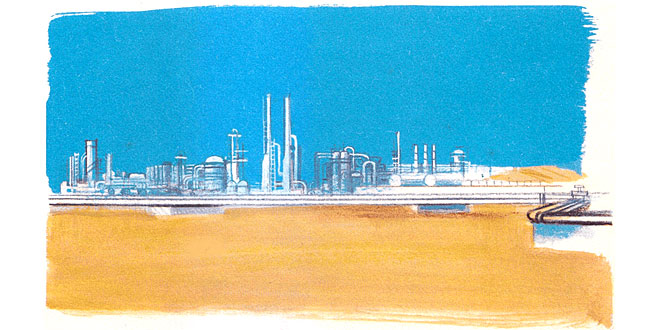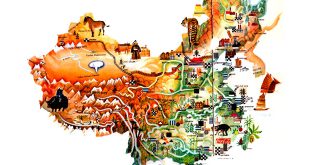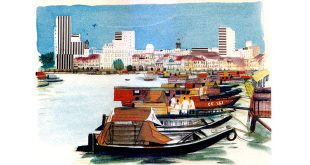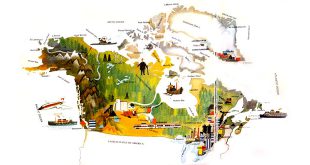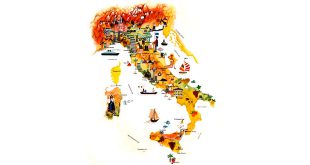Kuwait : Country Name
System of government: Sheikhdom
Capital: Kuwait City
Location: In the north-western corner of the Persian Gulf; land borders with Iraq and Saudi Arabia. Kuwait also includes several offshore islands
Area: 17,818 sq km
National composition: Arabs (about half are indigenous Kuwaitis and the rest are immigrants from other Arab nations)
Religion: Islam
Official language: Arabic
Currency: Kuwaiti dinar=1,000 fils
Administrative divisions: 3 governorates
Chief rivers: No permanent rivers
Climate: Hot and arid; temperatures reach as high as 70° C
Anthem: Al-Nasheed Al-Watani
Kuwait Map:
Kuwait Encyclopedia & Facts For Kids:
Its is a small, flat country with deserts, steppeland and a few oases in the interior. Only about 1,000 hectares of land are used to grow cereals, dates and vegetables.
However, revenue from oil sales has made this country so rich that the country has no income tax and the government provides free electricity, natural gas for household use, education, medical care and even drinking water produced by expensive desalination plants. Enormous sums have also been spent on the construction of luxurious housing, including irrigated gardens.
Geography:
The name is a diminutive of an Arabic word meaning “fortress built near water.”
Shaped roughly like a triangle, it borders the Persian Gulf to the east, with 121 miles (195 kilometers) of coast. The third side of the triangle is the 150 miles (240 kilometers) of historically contested border to the north and west that it shares with Iraq. Although the Iraqi government, which had first asserted a claim to rule Kuwait in 1938, recognized the borders with it in 1963, it continued to press Kuwait for control over Bubiyan and Warbah islands through the 1960s and 1970s. In August 1990, Iraq invaded Kuwait and, shortly thereafter, for a short period, formally incorporated the entire country into Iraq.
This country includes within its territory nine Persian Gulf islands, two of which, Bubiyan (the largest) and Warbah, are largely uninhabited but strategically important.
The island of Faylakah, at the mouth of Kuwait Bay, is densely inhabited. It is believed to be the outermost point of the ancient civilization of Dilmun, which was centered in what is present-day Bahrain. Faylakah is the site of an ancient Greek temple built by the forces of Alexander the Great.
Bubiyan is linked to the mainland by a concrete bridge. Following Kuwait’s liberation in 1991, the island was converted to a military base from which civilians are barred.
The most prominent geographic feature is Kuwait Bay, which indents the shoreline for about 25 miles (40 kilometers), providing natural protection for the port of Kuwait and accounting for nearly one half the state’s shoreline.
The total land area is 6880 square miles (17,818 square kilometers), which is slightly smaller than New Jersey in the United States.
This country consists mostly of desert and little difference in altitude. The lowest point is sea level while the highest point is an unnamed location of 1000 feet (306 meters).
This country enjoys a variable continental climate. Summers (April to October) are extremely hot and dry with temperatures exceeding 124°F (51°C) in Capital City several times during the hottest months of June, July and August. April and October are more moderate. Winters (November through February) are cool with some precipitation and average temperatures around 56°F (13°C) with extremes from -2°C to 27°C. The spring season (March) is warm and pleasant with occasional thunderstorms. The wettest months are January through March.
Natural hazards include sudden cloudbursts from October to April, bringing heavy rain that can damage roads and houses, as well as sandstorms and dust storms that occur throughout the year, but are most common between March and August.
Environmental concerns include limited natural fresh water, air and water pollution, and desertification. Some of world’s largest and most sophisticated desalination facilities provide much of the water.
Kuwait City, the capital, located at the heart of the country on the shore of the Persian Gulf, and containing it’s parliament (Majlis Al-Umma), most governmental offices, the headquarters of most Kuwaiti corporations and banks, is the indisputable political, cultural, and economic center of the emirate. Another city, Jahrah, is a 30-minute drive northwest of capital city. The main residential and business areas are Salmiya and Hawalli. The main industrial area is Shuwaikh within the Al Asimah governorate. The main palace headquarters is located in Bayan, a wealthy suburb in the Al-Jahra governorate.
External Links:
Business Events Happening In Kuwait:
- Kuwait Build: International Event for Building & Construction
- Kuwait Build & Design Week
- Kuwait Expo: Knowledge Transfer Across SMEs Expo, Kuwait
- Kuwait FoodEx: Kuwait Food & Beverage Industrial Expo
- The Luxury Show Arabia: Kuwait’s Premier Lifestyle & Luxury
 Kids Portal For Parents India Kids Network
Kids Portal For Parents India Kids Network
